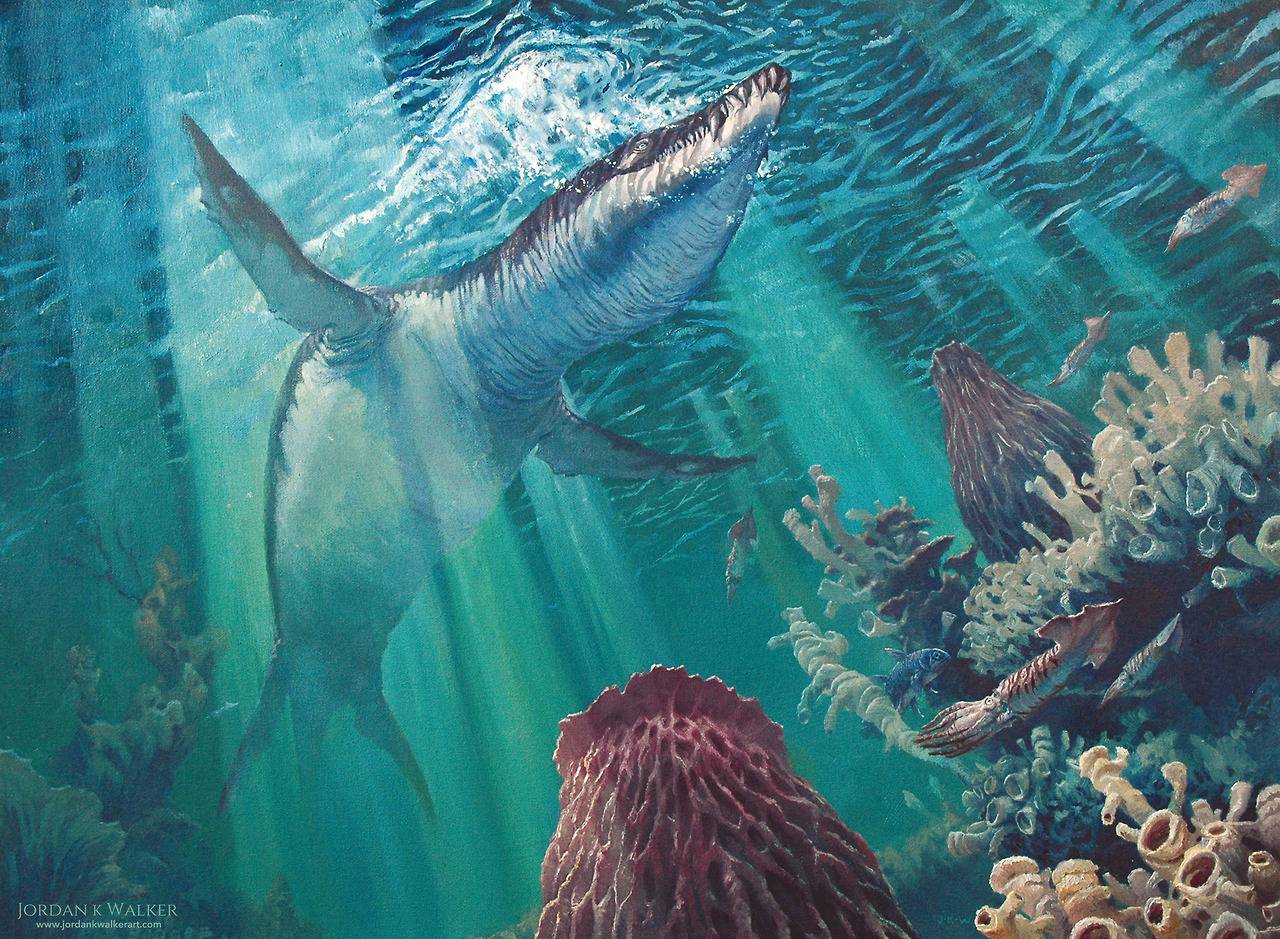Post by Infinity Blade on Jul 5, 2020 22:01:27 GMT 5
Simolestes spp.

Life reconstruction of Simolestes. © @ Jordan K. Walker->
Temporal range: Middle to Late Jurassic; Bajocian[1] to Tithonian[2] (~170 to ~145 Ma)
Scientific classification:
Life
Domain: Eukaryota
(unranked): Unikonta
(unranked): Opisthokonta
(unranked): Holozoa
(unranked): Filozoa
Kingdom: Animalia
Subkingdom: Eumetazoa
(unranked): Bilateria
Clade: Nephrozoa
Superphylum: Deuterostomia
Phylum: Chordata
Clade: Olfactores
Clade: Craniata
Subphylum: Vertebrata
Infraphylum: Gnathostomata
Clade: Eugnathostomata
Clade: Teleostomi
Clade: Tetrapoda
Clade: Reptiliomorpha
Clade: Amniota
Clade: Reptilia
Clade: Eureptilia
Clade: Romeriida
Clade: Diapsida
Clade: Neodiapsida
Clade: Sauria
Superorder: †Sauropterygia
Clade: †Eosauropterygia
Clade: †Pistosauroidea
Clade: †Pistosauria
Order: †Plesiosauria
Suborder: †Pliosauroidea
Family: †Pliosauridae
Clade: †Thalassophonea
Genus: †Simolestes
Species: †S. vorax, †S. indicus, †S. keileni
Simolestes is a genus of pliosaurid that lived in the Middle to Late Jurassic of France, India, and England.[2]
Description and ecology:
Like all plesiosaurs, Simolestes would have utilized a four-flippered method of swimming.[3]
Simolestes possessed a short cranium that was exceptionally wide and deep.[4] The orbits were more rounded than those of Peloneustes or Liopleurodon.[4 (video)]
Analysis of three different Jurassic pliosaur species has revealed variation in diet amongst them. While Peloneustes was a piscivore, and Liopleurodon indeed a predator of large hard-boned prey[4], the teeth of Simolestes were closely packed, stout, blunt, uncarinated, and rarely broken (though always very worn on the tips).[4 (video)] This cranial and dental morphology is said to resemble that of cephalopod-eating whales[4 (video)]. Therefore, Simolestes seems to have been primarily eating invertebrates, most likely cephalopods. This would have presented a problem for Simolestes: invertebrates contain a high amount of salt for their consumers, and reptiles cannot produce urine stronger than the blood plasma. It is therefore suggested that Simolestes had large salt-secreting glands that were probably located in its orbits, due to the close packing of the tooth roots and other organs in the skull.[4] This is not to say other, vertebrate-feeding pliosaurs (like Peloneustes and Liopleurodon) did not have salt-secreting glands, but that there would have been less of a need for them. Therefore, the salt-secreting glands of vertebrate eating pliosaurs were likely smaller than those of Simolestes.[4 (video)]

Skeletal reconstruction of S. vorax. © @ DeviantArt user SassyPaleoNerd->
References:
[1] Godefroit, P. (1994). Simolestes keileni sp. nov., un Pliosaure (Plesiosauria, Reptilia) du Bajocien supérieur de Lorraine (France).
[2] fossilworks.org/bridge.pl?a=taxonInfo&taxon_no=41508
[3] Muscutt, L. E., Dyke, G., Weymouth, G. D., Naish, D., Palmer, C., & Ganapathisubramani, B. (2017). The four-flipper swimming method of plesiosaurs enabled efficient and effective locomotion. Proceedings of the Royal Society B: Biological Sciences, 284(1861), 20170951.
[4] Noe, L.F. (2004). The evidence and implications of an invertebrate diet in Jurassic pliosaurs (Reptilia: Sauropterygia). Palaeontological Association Newsletter, 57(48th Annual Meeting Abstracts): 127. Recorded presentation of the abstract available->.

Life reconstruction of Simolestes. © @ Jordan K. Walker->
Temporal range: Middle to Late Jurassic; Bajocian[1] to Tithonian[2] (~170 to ~145 Ma)
Scientific classification:
Life
Domain: Eukaryota
(unranked): Unikonta
(unranked): Opisthokonta
(unranked): Holozoa
(unranked): Filozoa
Kingdom: Animalia
Subkingdom: Eumetazoa
(unranked): Bilateria
Clade: Nephrozoa
Superphylum: Deuterostomia
Phylum: Chordata
Clade: Olfactores
Clade: Craniata
Subphylum: Vertebrata
Infraphylum: Gnathostomata
Clade: Eugnathostomata
Clade: Teleostomi
Clade: Tetrapoda
Clade: Reptiliomorpha
Clade: Amniota
Clade: Reptilia
Clade: Eureptilia
Clade: Romeriida
Clade: Diapsida
Clade: Neodiapsida
Clade: Sauria
Superorder: †Sauropterygia
Clade: †Eosauropterygia
Clade: †Pistosauroidea
Clade: †Pistosauria
Order: †Plesiosauria
Suborder: †Pliosauroidea
Family: †Pliosauridae
Clade: †Thalassophonea
Genus: †Simolestes
Species: †S. vorax, †S. indicus, †S. keileni
Simolestes is a genus of pliosaurid that lived in the Middle to Late Jurassic of France, India, and England.[2]
Description and ecology:
Like all plesiosaurs, Simolestes would have utilized a four-flippered method of swimming.[3]
Simolestes possessed a short cranium that was exceptionally wide and deep.[4] The orbits were more rounded than those of Peloneustes or Liopleurodon.[4 (video)]
Analysis of three different Jurassic pliosaur species has revealed variation in diet amongst them. While Peloneustes was a piscivore, and Liopleurodon indeed a predator of large hard-boned prey[4], the teeth of Simolestes were closely packed, stout, blunt, uncarinated, and rarely broken (though always very worn on the tips).[4 (video)] This cranial and dental morphology is said to resemble that of cephalopod-eating whales[4 (video)]. Therefore, Simolestes seems to have been primarily eating invertebrates, most likely cephalopods. This would have presented a problem for Simolestes: invertebrates contain a high amount of salt for their consumers, and reptiles cannot produce urine stronger than the blood plasma. It is therefore suggested that Simolestes had large salt-secreting glands that were probably located in its orbits, due to the close packing of the tooth roots and other organs in the skull.[4] This is not to say other, vertebrate-feeding pliosaurs (like Peloneustes and Liopleurodon) did not have salt-secreting glands, but that there would have been less of a need for them. Therefore, the salt-secreting glands of vertebrate eating pliosaurs were likely smaller than those of Simolestes.[4 (video)]

Skeletal reconstruction of S. vorax. © @ DeviantArt user SassyPaleoNerd->
References:
[1] Godefroit, P. (1994). Simolestes keileni sp. nov., un Pliosaure (Plesiosauria, Reptilia) du Bajocien supérieur de Lorraine (France).
[2] fossilworks.org/bridge.pl?a=taxonInfo&taxon_no=41508
[3] Muscutt, L. E., Dyke, G., Weymouth, G. D., Naish, D., Palmer, C., & Ganapathisubramani, B. (2017). The four-flipper swimming method of plesiosaurs enabled efficient and effective locomotion. Proceedings of the Royal Society B: Biological Sciences, 284(1861), 20170951.
[4] Noe, L.F. (2004). The evidence and implications of an invertebrate diet in Jurassic pliosaurs (Reptilia: Sauropterygia). Palaeontological Association Newsletter, 57(48th Annual Meeting Abstracts): 127. Recorded presentation of the abstract available->.



